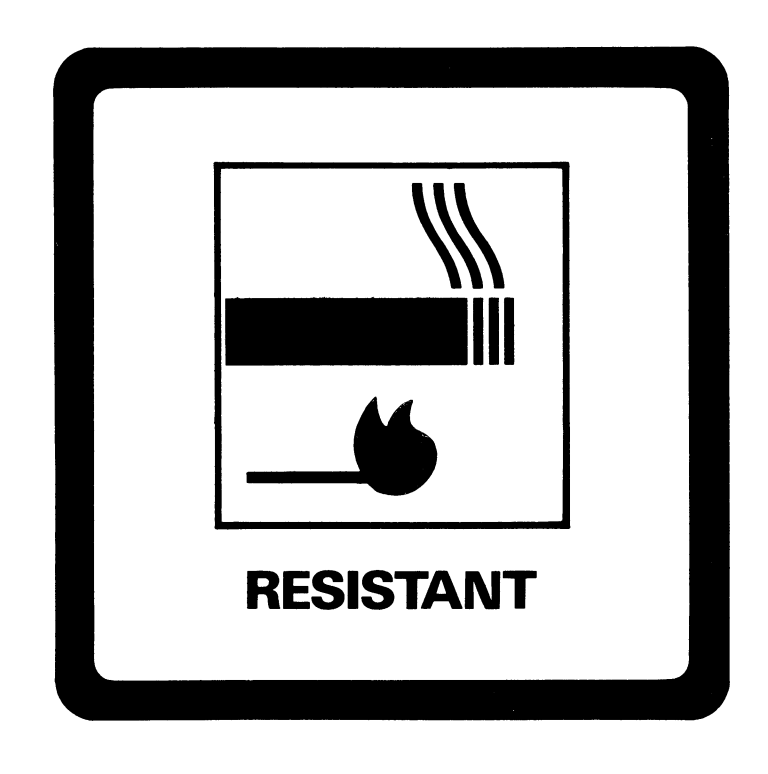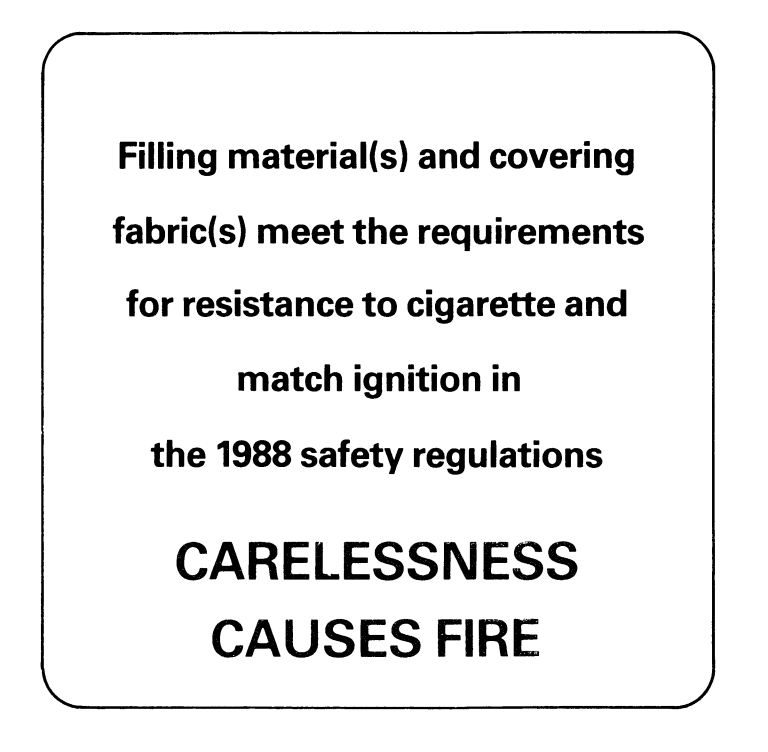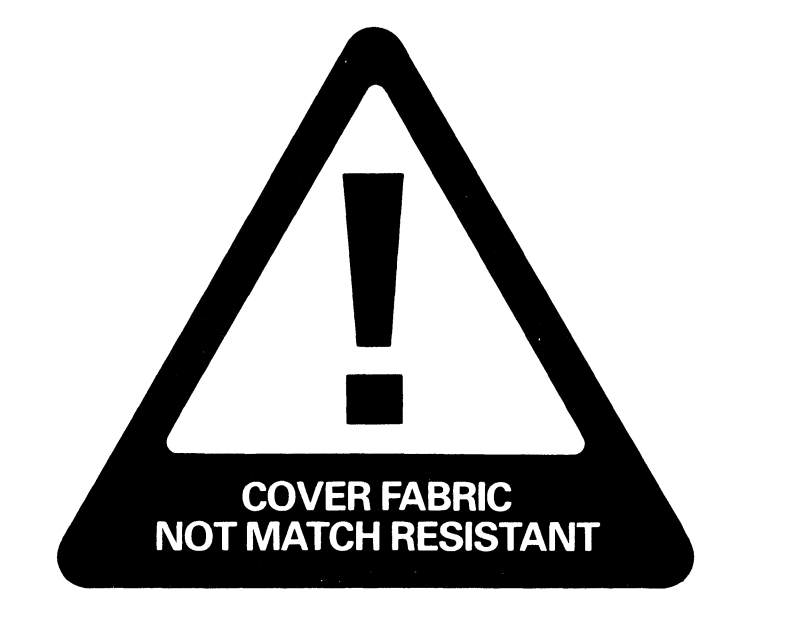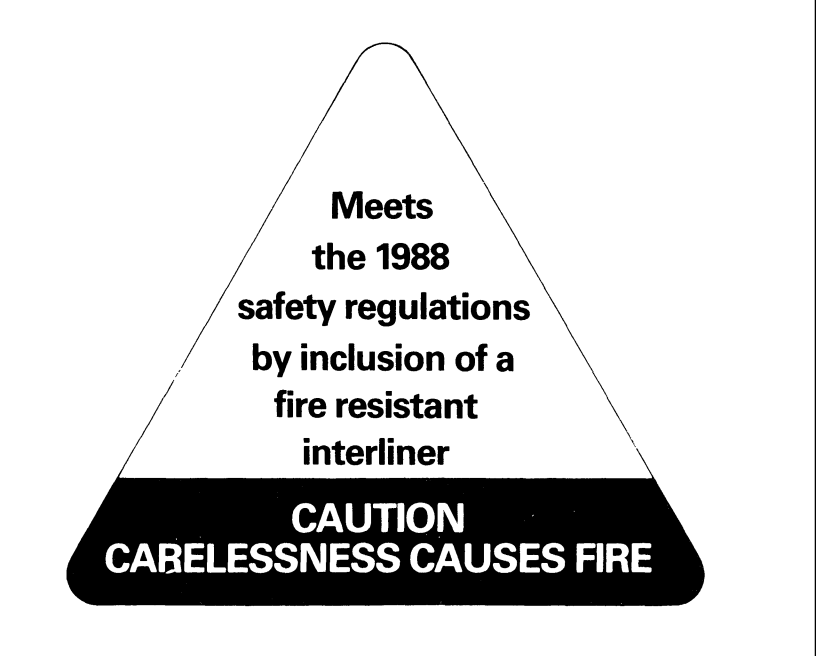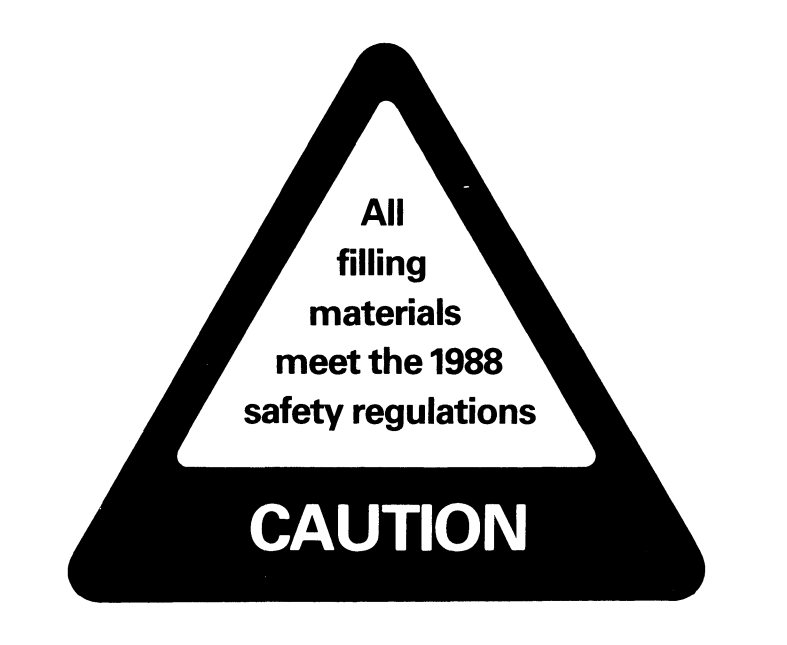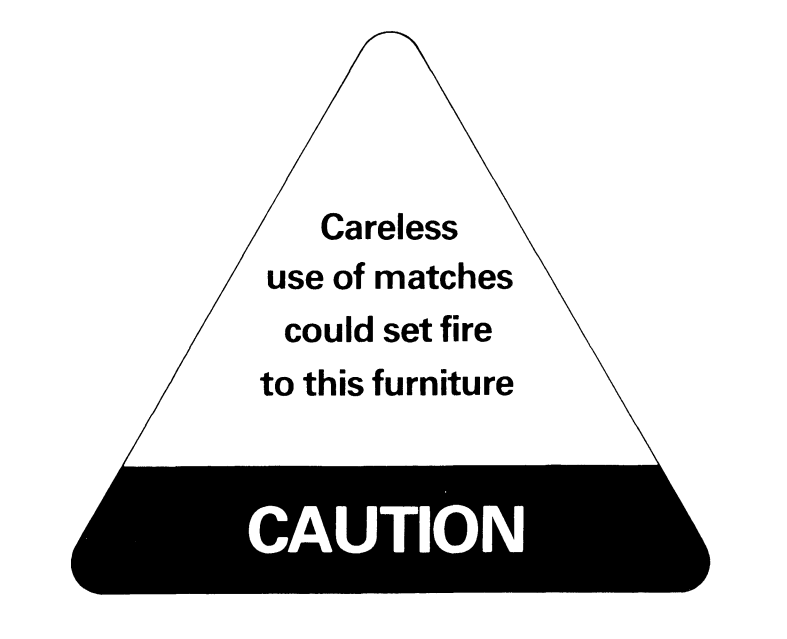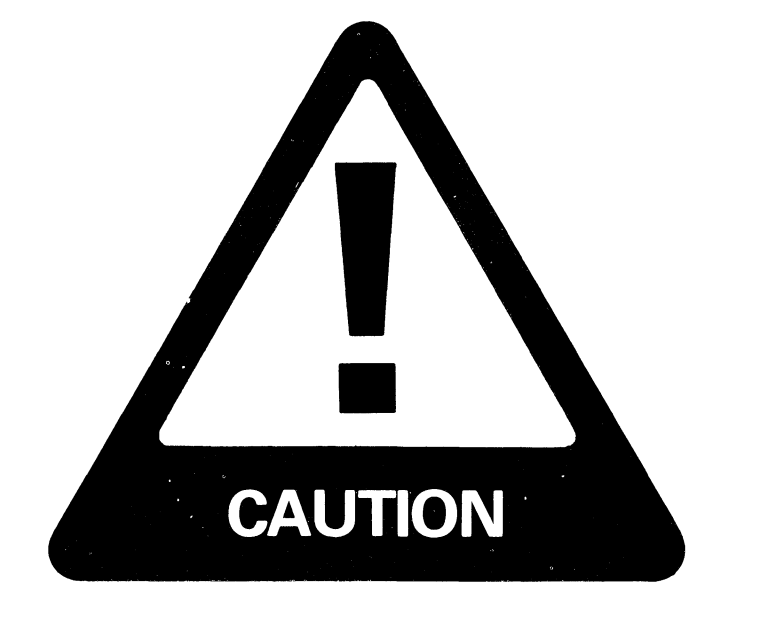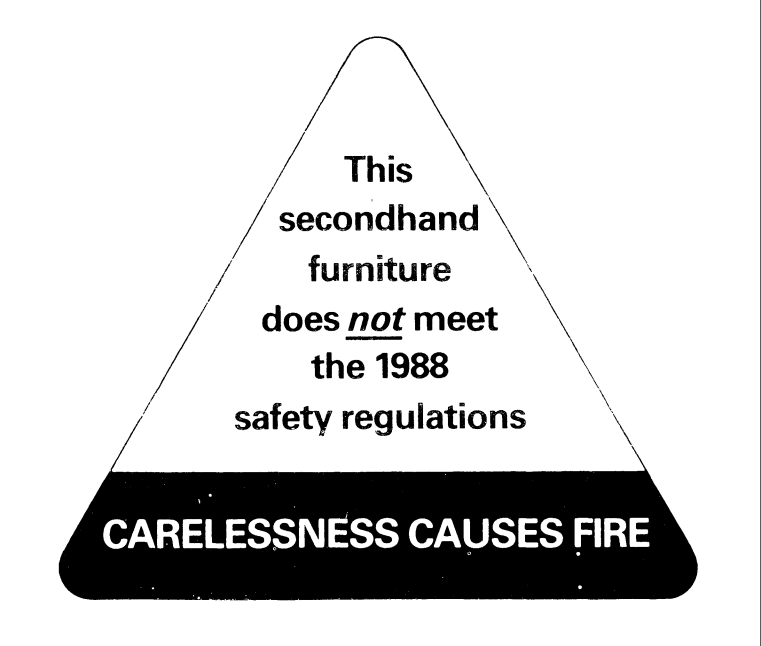Regulations 3, 6 and 7
SCHEDULE 1
PART I
Ignitability test for polyurethane foam in slab or cushion form.
1. The foam shall be tested in accordance with the method set out in BS 5852: Part 2 using cover fabric corresponding to the specification set out in paragraph 2 below.
2. The fabric shall be made of 100 per cent flame retardant polyester fibre. Its construction shall be woven to a plain weave. The yarn in the warp shall be of 1.6 decitex fibre, spun to a linear density of 37 tex, Z twist at 420 turns per metre. The fabric shall be woven to 20.5 yarn threads per centimetre in the warp.
The yarn in the weft shall be of 3.3 decitex fibre spun to a linear density of 100 tex, Z twist at 550 turns per metre. The fabric shall be woven to between 12.6 and 13 threads per centimetre in the weft.
The fabric finish shall be scoured and heat set. Its mass shall be 220 g per m2 plus or minus 5 per cent.
3. The test rig as specified in clause 6.1.1 of BS 5852: Part 2 shall have expanded steel platforms of not less than 28×6 mm mesh size. The test rig is placed on a metal tray of sufficient dimensions to collect any debris falling from specimens being tested. The rig and debris tray shall be mounted on a weighing balance with a remote readout having a full-scale deflection of at least 0 to 20 kg to an accuracy of 2 g.
4. The foam under test, cut to the specified dimensions is placed on the test rig, covered with the fabric specified in paragraph 2 above and tensioned with clips as set out in BS 5852: Part 2. An ignition source 5 crib is placed in position. The mass of the complete assembly is determined (“initial mass”). The test shall be carried out in accordance with BS 5852: Part 2. In particular flaming or smouldering failure shall be determined against the criteria of clause 4 of BS 5852: Part 2.
After flaming and smouldering has ceased, any debris which has become detached from the specimen shall be removed. The remaining mass of the assembly (“final mass”) is then recorded.
5. If failure against the criteria of clause 4 of BS 5852: Part 2 has occurred but only by way of damage exceeding the limits defined in clauses 4.1(e), 4.1(f) and 4.2(f) and provided that the resultant mass loss (initial mass less final mass) is less than 60 g the foam passes the ignitability test.
PART II
Ignitability test for polyurethane foam in crumb form.
1. The foam shall be tested in accordance with the method set out in BS 5852: Part 2 using cover fabric corresponding to the specification set out in paragraph 2 below.
2. The fabric shall be made of 100 per cent flame retardant polyester fibre. Its construction shall be woven to a plain weave. The yarn in the warp shall be of 1.6 decitex fibre, spun to a linear density of 37 tex, Z twist at 420 turns per metre. The fabric shall be woven to 20.5 yarn threads per centimetre in the warp.
The yarn in the weft shall be of 3.3 decitex fibre spun to a linear density of 100 tex, Z twist at 550 turns per metre. The fabric shall be woven to between 12.6 and 13 threads per centimetre in the weft.
The fabric finish shall be scoured and heat set. Its mass shall be 220 g per m2 plus or minus 5 per cent.
3. The test rig panels are lined with the fabric specified in paragraph 2 above. Sufficient crumb foam shall be placed upon the seat and back panels so that when the cover fabric piece is placed over them, both are stuffed to the density used in the furniture as intended. The test is then carried out in accordance with BS 5852: Part 2 using ignition source 2 as specified therein.
4. If smouldering or flaming failure against the criteria of clause 4 of BS 5852: Part 2 has not occurred or has occurred only by way of damage exceeding the limits defined in Clauses 4.1(e), 4.1(f) and 4.2(f), the crumb foam passes the ignitability test.
PART III
Ignitability test for latex rubber foam.
1. The foam shall be tested in accordance with the method set out in BS 5852: Part 2 using cover fabric corresponding to the specification set out in paragraph 2 below.
2. The fabric shall be made of 100 per cent flame retardant polyester fibre. Its construction shall be woven to a plain weave. The yarn in the warp shall be of 1.6 decitex fibre, spun to a linear density of 37 tex, Z twist at 420 turns per metre. The fabric shall be woven to 20.5 yarn threads per centimetre in the warp.
The yarn in the weft shall be of 3.3 decitex fibre spun to a linear density of 100 tex, Z twist at 550 turns per metre. The fabric shall be woven to between 12.6 and 13 threads per centimetre in the weft.
The fabric finish shall be scoured and heat set. Its mass shall be 220 g per m2 plus or minus 5 per cent.
3. The foam under test cut to the specified dimensions is placed on the test rig, covered with the fabric specified in paragraph 2 above and tensioned with clips as set out in BS 5852: Part 2. The test is then carried out using ignition source 2 as specified therein.
4. If smouldering or flaming failure against the criteria of clause 4 of BS 5852: Part 2 does not occur, the latex rubber foam passes the ignitability test.
Regulations 3, 6 and 7
SCHEDULE 2
PART I
Ignitability test for non-foam filling materials singly.
1. The filling material shall be tested in accordance with the method set out in BS 5852: Part 2 using cover fabric to the specification in paragraph 2 in Part I of Schedule 1 to these Regulations.
2. The specimen comprising the filling material to be tesed and the specified cover fabric shall be tested with ignition source 2 as specified in BS 5852: Part 2. Where the filling material is loose it shall be packed as indicated in paragraph 3 in Part II of Schedule 1.
3. If smouldering or flaming failure against the criteria of clause 4 of BS 5852: Part 2 has not occurred or has occurred only by way of damage exceeding the limits defined in clause 4.1(e), 4.1(f) and 4(2)(f) the non-foam filling passes the ignitability test.
PART II
Ignitability test for composite fillings for furniture other than mattresses, bed-bases, cushions and pillows.
The composite fillings, covered with the primary cover are built up on the test rig as described in BS 5852: Part 2. The covering fabric shall be that specified in paragraph 2 in Part I of Schedule 1. The test procedure with the use of ignition source 2 specified in BS 5852: Part 2 and the criteria of failure shall be as specified therein.
PART III
Composite test for ignitability of pillows and cushions with primary covers.
1. For pillows the test specimen shall comprise the filling and the primary cover of the pillow. Where the filling is of a loose nature the specimen shall be prepared as set out for loose fillings in paragraph 3 in Part II of Schedule 1. The test procedure using ignition source 2 shall be as specified in BS 5852: Part 2. If smouldering or flaming failure against the criteria of clause 4 of BS 5852: Part 2 has not occurred or has occurred only by way of damage exceeding the limits defined in clause 4(1)(e), 4(1)(f) and 4(2)(f), the composite pillow filling passes the ignitability test.
2. For cushions with primary covers the test specimen shall be made up of filling, the primary cover and standard fabric as in Schedule 1 Part I, paragraph 2. Where the filling is loose, it shall be packed as set out in Schedule 1 Part II, paragraph 3. The test procedure using ignition source 2 shall be as specified in BS 5852: Part 2. If smouldering or flaming failure against the criteria of clause 4 of BS 5852: Part 2 has not occurred or has occurred only by way of damage exceeding the limits defined in clause 4(1)(e), 4(1)(f) and 4(2)(f) the composite cushion filling passes the ignitability test.
PART IV
Ignitability test for composite fillings of mattresses and bed-bases.
1. The test specimen shall be prepared as set out in BS 6807. It may be constructed from the filling materials to be used or by removing existing ticking from a mattress or upholstered divan or bed-base.
2. The specified test fabric as in Schedule 1 Part I paragraph 2, shall be used as the cover fabric. It shall be fitted so as to reproduce the tension in the original article where this is being tested.
3. The test shall be carried out according to Section Four of BS 6807 using ignition source 2 as specified in BS 5852: Part 2. Smouldering or flaming failure shall be as defined in BS 5852: Part 2.
Regulation 8(2)
SCHEDULE 3
Ignition resistance test for interliner.
1. An interliner which is a fabric that has been treated with a fire-retardant chemical to reduce the ignitability of the upholstery shall, before it is conditioned in accordance with clause 7.1 of B.S. 5852: Part 1, be subjected to the water-soaking procedure set out in clauses 4.2 to 4.5 of B.S. 5651, save that for the second subclause of clause 4.5 there shall be substituted the following:
“After 30 minutes, remove the specimen, rinse in water (4.2.1) using a liquor ratio of 1:20 for 2 minutes, and then dry the specimen by any method suitable for the fabric type.”
2. The interliner, water-soaked or not as the case may be, shall be tested using cover fabric corresponding to the specification set out in paragraph 3 below and foam filling corresponding to the specification set out in paragraph 4 below. The test shall be conducted using ignition source 5 of BS 5852: Part 2.
3. The fabric shall be made of 100 per cent flame retardant polyester fibre. Its construction shall be woven to a plain weave. The yarn in the warp shall be of 1.6 decitex fibre, spun to a linear density of 37 tex, Z twist at 420 turns per metre. The fabric shall be woven to 20.5 yarn threads per centimetre in the warp.
The yarn in the weft shall be of 3.3 decitex fibre spun to a linear density of 100 tex, Z twist at 550 turns per metre. The fabric shall be woven to between 12.6 and 13 threads per centimetre in the weft.
The fabric finish should be scoured and heat set. Its mass shall be 220 g per m2 plus or minus 5 per cent.
4. The filling material for the test shall be non fire-retardant polyurethane foam corresponding to the specification set out in BS 3379 Type B Hardness grade 130 and of a density of 20–22 kg per m3.
5. The criteria of failure shall be those specified in clause 4 of BS 5852: Part 2.
Regulations 3 and 5
SCHEDULE 4THE CIGARETTE TEST
Modifications to BS 5852: Part 1
1. Appendix A of B.S. 5852: Part 1 shall be disregarded.
2. All braids and other trimmings shall be removed from material upon which a test is to be conducted.
3. Any covering fabric or fire-barrier material which has been treated with a fire-retardant chemical to reduce the ignitability of the upholstery shall, before it is conditioned in accordance with clause 7.1 of B.S. 5852: Part 1, be subjected to the water-soaking procedure set out in clauses 4.2 to 4.5 of B.S. 5651, save that for the second subclause of clause 4.5 there shall be substituted the following:
“After 30 minutes, remove the specimen, rinse in water (4.2.1) using a liquor ratio of 1:20 for 2 minutes, and then dry the specimen by any method suitable for the fabric type.”
4. Where a test is to be conducted in respect of furniture which has no upholstered back and no upholstered arms, the materials on the test rig shall be arranged as if the furniture had an upholstered back the upholstery of which consisted of the same materials as the upholstery of the seat; and where a test is to be conducted in respect of furniture which has an upholstered back or upholstered arms but no upholstered seat, the materials on the test rig shall be arranged as if the furniture had an upholstered seat the upholstery of which consisted of the same materials as the upholstery of the back or arms.
5. Where the upholstery to be tested is such that the materials in one part of the furniture are not the same as those in another part, separate tests shall be conducted in respect of each part as if each part were the seat of furniture which had no upholstered back and no upholstered arms, save that no test shall be conducted in respect of a part the upholstery of which consists of the same materials as the upholstery of a part in respect of which a test has already been conducted; and in this paragraph, “part” means the back, the seat or the arms.
6. Where seams are exposed as part of the design of the covering material, at least one seam in respect of each test to be conducted shall be so aligned on the test rig that it crosses the junction of the back and the seat at approximately right angles thereto and not less than 50 mm from the nearest side edge, and the test (or, in the case of a test which is repeated, the first test) shall be conducted with the cigarette placed across the seam at that junction.
Regulations 3, 8 and 9
SCHEDULE 5THE MATCH TEST
PART I
1. All braids and other trimmings shall be removed from material upon which a test is to be conducted.
2. Any covering fabric which has been treated with a fire-retardant chemical to reduce the ignitability of the upholstery shall, before it is conditioned in accordance with clause 7.1 of B.S. 5852: Part 1 be subjected to the water-soaking procedure set out in clauses 4.2 to 4.5 of B.S. 5651, save that for the second subclause of clause 4.5 there shall be substituted the following:
“After 30 minutes, remove the specimen, rinse in water (4.2.1) using a liquor ratio of 1:20 for 2 minutes, and then dry the specimen by any method suitable for the fabric type.”
3. The test shall be carried out in accordance with those provisions of BS 5852: Part 1 which relate to butane flame ignition source 1. The filling material for this test shall be non-fire retardant polyurethane foam corresponding to the specification set out in BS 3379 Type B Hardness grade 130 and of a density of 20–22 kg per m3.
4. The criteria of failure shall be those specified in clause 4 of BS 5852: Part 1.
PART IITHE MATCH TEST FOR STRETCH COVERS
The test for stretch covers shall be conducted in the same way as for other cover materials except that the filling material over which the fabric is tested shall be a foam which passes the ignitability test in Part I of Schedule 1 and which has a density of 24–26 kg per m3.
Regulation 10
SCHEDULE 6
PART I
1. This Schedule applies to all furniture except mattresses, bed-bases, pillows and cushions.
2. The appropriate display labels are set out in Parts II, III and IV of this Schedule.
3. The display label shall be substantially in the form (including size, colours used and size and type of print used) of the label in Part II, III or IV of this Schedule, as the case may be.
4. In the case of furniture sold as a collection of pieces (such as three-piece suites) the appropriate display label shall be attached to each individual piece.
PART II
Where the requirements of regulations 5, 6, and 8(1) of these Regulations are complied with the appropriate display label is:–
PART III
Where the furniture has a permanent cover which does not pass the test in regulation 8(1) but has an interliner which passes the test in Schedule 3 to these regulations and the furniture satisfies the requirements of regulations 5 and 6 the appropriate display label is:–
PART IV
During the period between 1st March 1989 and 28th February 1990 where only the requirements of regulations 5 and 6 are complied with the appropriate display label is:–
Regulation 11
SCHEDULE 7PERMANENT LABELLING REQUIREMENTS
PART I
1. This Schedule applies to all furniture (except mattresses and bed-bases) which includes upholstery and to the covers referred to in regulation 9(1) and (2) above.
PART II
1. Subject to paragraphs 2 and 3 below, articles mentioned in Part I of this Schedule shall bear a label which sets out, in order, the following–
(a)the words “CARELESSNESS CAUSES FIRE”;
(b)the name and the postal code of the address of the principal place of business of the manufacturer or importer who first supplied the article in the United Kingdom;
(c)the batch number or identification number (if any) of the article in question;
(d)the date on which the article was manufactured or imported (in its finished form) into the United Kingdom;
(e)the description of all the filling materials included in the article;
(f)the description of all the covering materials included in the article; and
(g)whether or not the article includes an interliner which passes the test in Schedule 3 to these Regulations.
2.—(a) the matters set out in subparagraphs (c), (d), (f) and (g) of paragraph 1 above need not appear on labels required for cushions and pillows;
(b)the matters set out in sub-paragraphs (c), (d) and (g) of paragraph 1 above need not appear on labels required for:
(i)cots, carry-cots, playpens, prams and pushchairs;
(ii)any other article similar in its nature and use to any article in b(i) above and designed to contain a baby or small child.
3. The matters set out in subparagraphs (c), (d), (e) and (g) of paragraph 1 above need not appear on labels required for covers.
4. The labels specified in this Part of this Schedule may, in the case of covers, appear anywhere on the cover and, in the case of other articles, shall appear on an external surface of the article but in every case the labels shall not appear so as to obscure any label or mark required to appear on the article by or under any enactment.
5. In the case of furniture sold as a collection of pieces (such as three-piece suites) and in the case of covers which are so sold the label shall be attached to each individual piece.
6. The wording and numbering specified in this Part of this Schedule shall appear in medium letters of at least 10 point in upper or lower case and shall be set out in legible and durable form on a background of a sufficiently contrasting colour to enable the wording and numbering to be clearly seen.
The label on which the wording and numbering appears shall itself be durable and shall be securely attached to the article in question.
PART III
1. Subject to paragraphs 2 and 3 below, articles mentioned in Part I of this Schedule shall bear a label which sets out, in order, the following–
(a)the words “CARELESSNESS CAUSES FIRE”;
(b)the batch number or identification number (if any) of the article in question;
(c)whether or not the article includes an interliner which passes the test in Schedule 3 to these Regulations; and
(d)a summary of the measures which have been taken to ensure that the article complies with the requirements of these Regulations.
2. The matters set out in subparagraphs (b) and (c) of paragraph 1 above need not appear on labels required for–
(a)cushions and pillows;
(b)cots, carry-cots, playpens, prams and pushchairs;
(c)any other article similar in its nature and use to any article in subparagraph (b) above and designed to contain a baby or small child;
(d)covers.
3. The labels specified in this Part of this Schedule may, in the case of covers, appear anywhere on the cover and, in the case of other articles, shall appear on an external surface of the article but in every case the labels shall not appear so as to obscure any label or mark required to appear on the article by or under any enactment.
4. In the case of furniture sold as a collection of pieces (such as three-piece suites) and in the case of covers which are so sold the label shall be attached to each individual piece.
5. The wording and numbering specified in this Part of this Schedule shall appear in medium letters of at least 10 point in upper or lower case and shall be set out in legible and durable form on a background of a sufficiently contrasting colour to enable the wording and numbering to be clearly seen.
The label on which the wording and numbering appears shall itself be durable and shall be securely attached to the article in question.
Regulation 14(3)
SCHEDULE 8
Display label for second-hand furniture in period before regulation 14(2) comes into force (that is, before 1st March 1993).
The display label required by regulation 14(3) (subject to regulation 14(4) ) to be attached to furniture which regulation 14(1) applies in the period before 1st March 1993 is:–

